Creature with the Atom Brain, The Giant Claw, The Werewolf, Zombies of Mora Tau (1955, 1956, 1957)
Directed by: Edward L. Cahn, Fred F. Sears
Written by: Bernard Gordon, Curt Siodmak, George H. Plympton, Robert E. Kent
Starring: Allison Hayes, Angela Stevens, Gregg Palmer, Jeff Morrow, Joyce Holden, Mara Cordey, Richard Denning, Steven Ritch
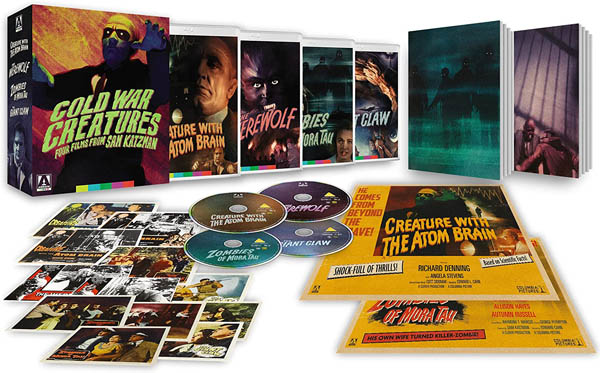
COLD WAR CREATURES: FOUR FILMS FROM SAM KATZMAN
AVAILABLE ON BLU-RAY: NOW, from ARROW VIDEO
The name of producer Sam Katzman may not be one that you’ve heard of. In fact to be honest he wasn’t a name I’d heard of until I looked him up and realised I’d seen some of his films. He made a huge number of low budget efforts in various genres, “the bread and butter of the industry” as he called them, every single one of which made money. In a sort of ‘special edition’ of a DVD boxset from Sony with different but far superior extras, Arrow Video have collected together four of his science fiction-horror movies, one of which, The Giant Claw, has a reputation as being an absolute hoot, a ‘so bad it’s good’ classic. So we know that we certainly ain’t talking Val Lewton here, but hopefully we’ll have lots of fun….
DISC 1 – CREATURE WITH THE ATOM BRAIN
RUNNING TIME: 69 mins
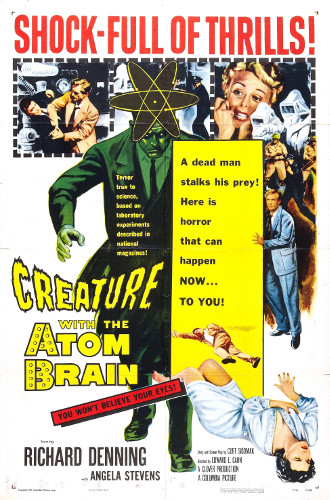
Gangster Jim Hennesy and District Attorney McGraw are brutally murdered by a super-strong man who’s impervious to bullets, before returning to his controllers, crime lord Frank Buchanan and scientist Wilhelm Steigg. Steigg has perfected a process using atomic energy that allows him to resurrect the dead and take control of their minds, turning them into obedient workers, but Buchanan is using these zombies for a different purpose. Crime lab doctor Chet Walker and police Capt. Dave Harris suss out the connection between the two victims and Buchanan, and place the remaining victims in police custody, but Buchanan formulates a very clever plan to get at them….
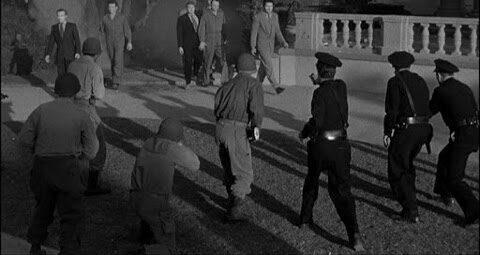
Suspense or surprise, that is the question. It probably seems like I’ve given more away in my above synopsis than I normally do, but in fact we learn most of what’s happening in only the film’s second scene, which is quite unusual; generally we’d gradually find things out along with our hero or heroes, but instead the only thing that we have to wait for a little while to find out is why the bad guys are doing what they do, and most of us would probably imagine that it’s revenge for something, though here it’s for driving Buchanan out of the country. In any case, the attempt is therefore mostly on suspense in this slightly uneven but engrossing combination of police procedural and science fiction-horror which initially gives the impression of being a talk fest but which gets more and more exciting as it goes along, even if the low budget holds things back a little, with for example what could potentially have been the most thrilling sequence in the whole film – Buchanan’s zombies causing disasters to happen all over the city – being reduced to a tiny montage of models and real footage. And then there’s those shots where the film has clearly been paused. But there’s some vivid imagery that may stick in your mind. Buchanan and Steigg in radiation suits constantly having to crawl through what looks like some sort of embryonic white plastic tunnel to get to their lab. The sight of one of the control devices, resembling some very large metallic insect, which makes us ask the question; how the hell do they manage to put these huge things inside people’s heads? A shot of a doll, which we’ve got attached to as it belongs to our hero’s daughter’s, torn to bits doll; god, these zombies, who also break people in half in silhouette, are nasty.
The titles take place over the sound of a beating heart with a great image of a darkened figure surrounded by trees advancing towards the camera. Two gun shots being fired into the camera give even me an impression that director Edward L. Khan, best known for the Alien precedent It! The Terror From Beyond Space and possibly Invasion Of The Saucer Men, is going to provide some real style here, but, despite some fine editing during some of the chatty sequences [which can be put down as much to editor Aaron Stel], this doesn’t turn out to be the case except for zombie faces looming into the camera. This first zombie breaks into a casino and kills somebody with the words “I told you I’d come back” before surviving bullets fired at him by employees [we even see squibs which wasn’t common back then] and then being directed to return by a watching Steigg; the idea of a TV screen which receive images from the zombie’s eyes is great, even if the POV isn’t always quite right. Walker doesn’t get much time with his wife Joyce and daughter Penny because Harris keeps on popping over to tear him away from them. You’d think that, even in 1955, Joyce, who shares a surprisingly intimate scene with her husband on their bed, would be sick of this but if she is she certainly doesn’t show it. But then again she seems to have trouble opening a door. The investigation proceeds with lots of scientific chat but also some humour, from our heroes following Stiegg into a pub with a geiger counter to a newscaster trying not to piss himself as he reads out the news about radio active zombies. The press initially don’t believe this seeming nonsense either, but that doesn’t last for long as more and more killings take place, and placing victims-to-be in custody isn’t of much help. Lots of scenes featuring the zombies, one of whom is a real surprise though this subplot fails to lead to the expected emotion, and whizzing around in cars take over for an extremely fast paced second half, finishing with cops vs. zombies. It’s not a particularly well staged set piece, something that Khan tries to make up for by sticking in lots of shots of the zombies – yes – you’ve got it – looming into the camera.
One can chuckle at how the zombies often seem to go unnoticed despite their lumbering walk, emotionless talking and those bloody great big scars on their head, and be baffled at not one but two scenes involving them and windows, but they’re nonetheless quite sinister in an Invaders From Mars [this may have also scared me as a kid?] way and, rather than using a gun [or maybe they can’t?], prefer to kill their victims in a variety of other ways. One murder set piece with two cops is quite startling even if the violence is just suggested. While the script, written by Kurt Siodmak of The Wolf Man and Donovan’s Brain fame, is very successful in balancing seriousness with just a little bit of almost tongue-in-cheek humour, it falls down a bit is in omitting potential character conflict, especially between Buchanan and Steigg; we get a sense of their relationship but could have done with more of this, as well as material involving two other characters; it’s as if Siodmak omitted some stuff at the last minute because he realised the film may be too long, or maybe the scenes were in the script but not filmed. Performances remain just average with star Richard Denning, not new to battling creatures though here playing someone who’s both a cop and a scientist, his usual self, not much of an actor but with quite a strong presence. Overall there’s quite a lot to enjoy in the often inventive and lively Creature From The Atom Brain, which formed the bottom half of a double bill with It Came From Beneath The Sea but is actually the better film despite the other one featuring the work of Ray Harryhausen.
Rating: 









SPECIAL FEATURES
Brand-new introduction by historian and critic Kim Newman [8 mins]
Newman provides a nice, relatively spoiler-less introduction, telling us some information about Katzman who was a more prestigious producer in his early days, pointing out where there’s some footage from another film, and saying how Bill Warren, noted writer about these types of movies, saw the double bill containing this and It Came From Beneath The Sea at age ten and thought they were the greatest movies ever made.
Brand-new audio commentary by critic Russell Dyball
Dyball is not a name I’d come across before, but I want to hear more from him because his commentary track here is superb. While he’s still happy to point out flaws, threaded throughout is a passionate defense of Katzman and producers/directors like him who just made pictures to make money but who tried to make them as good as possible, while we also get lots of scene-specific observations including a precise look at the editing and shooting of certain moments, paralleling of one pair of characters with another, an inaccuracy in the film’s ‘facts’ pointed out – and no listing of people’s credits – which makes it even more remarkable that Dyball manages to talk about this movie for so long with only a few minor diversions. This track should be held up as an example of how this should be done.
Sam Katzman: Before and Beyond the Cold War Creatures, a brand-new feature-length illustrated presentation on the life, career and films of Sam Katzman by historian and critic Stephen R. Bissette [73 mins]
Bissette sure loves Kaztman’s work, beginning his talk against a background of Katzman memorabilia, which leads me to believe that all the posters [and a comic adaptation which contains those pesky lizards masquerading as dinosaurs from One Million B. C. that turned up in so many cheapies for over two decades] that then dominate the piece while Bissette talks, are his. Early on we get a fact that explains why Katzman’s films and serials [which include two Superman ones] did so well commercially; he would go around the country and talk as many states as possible into showing them. We get a potted history of Katzman’s career, which includes Bela Lugosi starrers for Monogram, a series called Jungle Jim starring Johnny ‘Tarzan’ Weismuller, and a serial called Captain Africa. He goes into the four films in this set but not in as much detail as we have loads given away to us about the plots; instead they whet our appetites. This is a terrific special feature which never bores.
Condensed Super 8mm version of Creature with the Atom Brain, produced for home cinema viewing [11 mins]
This carefully chosen selection of scenes, some edited down, form quite a good truncation. We must remember; before video, watching these versions on a projector was the only way people could view films they liked at home.
Theatrical Trailer [2 mins]
Image Gallery
DISC 2 – THE WEREWOLF [1956]
RUNNING TIME: 80 mins

In Mountaincrest, a stranger who’s lost his memory has a drink in a bar then turns into a wolf to kill local thug Joe Mitchell who tried to rob him as well as wounding Deputy Ben Clovey. Sheriff Jack Haines organizes a party to find the beast. Meanwhile nurse Dr. Jonas Gilchrist and nurse Amy Standish receive the same man who calls himself Duncan Marsh. He admits killing Jo and recalls that he had a car accident and that two doctors treated him, but he flees when offered a sedative which terrifies him. Sheriff Jack Haines wants to hunt him down and kill him but Amy and her father want him to capture Duncan to see how they could treat him, while his wife and son also show up….
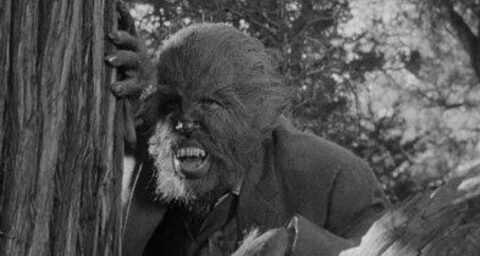
The Werewolf begins with a voiceover from Katzman himself telling us what lycanthropy is, which seems a bit odd even in 1956, but then this was the first werewolf film in some time. While Creature From The Atom Brain added science to the concept of zombies, it wasn’t actually the first film to do so; however this effort was the first to do it for werewolves in what is a similar plot to 1942’s Man-Made Monster which, coincidentally, starred the Wolf Man himself Lon Chaney Jnr. The scene about a third of the way through is a particularly daft example of its kind, as our two very mad scientists Morgan Chambers and Emery Forrest discuss in a seriously sober fashion how they’ve injected poor Duncan Marsh with “irradiated wolf serum”, which they’d never before used on humans. They believe that the serum, when perfected, will allow “a select minority of people” — chosen by them — to survive the unavoidable nuclear holocaust that’s coming. For now though, lycanthropy is an unfortunate side effect. So in this world of fear over progress and Cold War anxiety there are no full moons; this werewolf transforms whenever he’s agitated or angry much like The Hulk, and prowls around in the daytime too. However, it rarely feels particularly threatening, being hunted for much of the running time by lots of people across well shot snowy landscapes around the California resort town of Big Bear Lake, doubling for Montana, instead of the usual sets that horror fans would have been more familiar with. In fact this film goes quite heavy on the pathos, meaning that we really don’t want this werewolf, who only kills three people who are all dislikeable, to be caught and slain. Stephen Ritch delivers a performance of some power as Marsh so we really feel his agony and his torment. In fact I’d say he’s better than Chaney.
A fantastic shot of the main street of a small town with a figure slowly coming down out and towards the camera sets up the opening act which, like that of Creature From The Atom Brain, is designed to grab you. The man stumbles into a bar and has a drink before leaving and being hassled for money by a lout. The two go into an alleyway but then we cut to outside and just see legs moving, growling and screams as a woman walks by and looks with horror upon the sights of both a gruesome death and the face of this monster, neither of which we see. Deputy Ben Clovey and two others track wolf foot prints which become human shoe prints and are understandably puzzled. Then Clovey is attacked but we only see him describe the assault afterwards, which is disappointing. “Maybe it had hands covered with hair, or maybe it had paws like a wolf, but it wasn’t All wolf – I didn’t have much time to see”. A posse, wielding torches which brings back memories of all those mobs who usually saved the day in Universal horror movies, as well as guns, is soon formed, but also hunting Marsh are the two doctors who aren’t above committing more misdeeds in their quest to rid the world of their enormous misdeed. And then there’s his wife Helen [unusual to have a werewolf married] and their preteen son Chris, who are allowed to go along with Sheriff Jack Haines and nurse Amy Standish to also find Marsh, leading to some rather emotional scenes. But the pace considerably slackens after a while, a problem with some other manhunt movies, and the climax mostly takes place with the werewolf in the distance, time presumably not allowing for many closeups unless this was an intentional device by director Fred Sears [whose Earth Vs The Flying Saucers was double billed with this film] to show how helpless he is.
James B. Gordon’s script attempts seriousness and mostly succeeds. The werewolf makeup, which is almost identical to the one in Return Of The Vampire and was reused with some variation in the next year’s far better known and actually more interesting I Was A Teenage Werewolf, is okay and our first sight of him, saliva dripping from his mouth, has some impact. The first onscreen transformation suffers from terribly mismatching dissolves but the second and third aren’t as bad; I wonder why? A sign of a rushed production maybe. Ritch emotes well underneath his makeup, even managing to bring out some of the sadness that he brings in spades to his human side. Cinematographer Edward Linden uses shadows and darkened figures well, employs quite a few low angles for some scenes, and even employs prison bars reflected on a wall to good effect in one scene, while there’s plenty of blood when our creature is caught in a bear trap laid expressly for that purpose; the werewolf tears himself free. George Cisar is amusing as the drunken pub boor who goes on about how he caught [briefly] the monster; you know that something bad is going to happen to him, though it doesn’t come from the expected source. The Werewolf is average fare, not at all bad and certainly pretty well made, perhaps the most technically proficient of these four films, but not really doing enough with its premise and almost marking time in places where it could have been ramping up the fear, us werewolf likers missing the expected staking sequences. But then again this werewolf is treated as a victim than any other werewolf I’ve seen; we’re far more scared of Chambers and Forrest. And we do feel extremely sad for him, so in that respect the film really succeeds.
Rating: 









SPECIAL FEATURES
Brand-new introduction by critic Kim Newman [13 mins]
Newman likes this one quite a bit, claiming that it’s the best of Sears’s pictures, so seems to enjoy talking about a film even more than normal. He says how it’s right that Katzman is named as the auteur of these four movies, goes through the interesting career of Sears who made four teen musical-orientated efforts which were all very successful, and places The Werewolf in its rightful place in the often intersecting sci-fi and horror genres.
Brand-new audio commentary by critic Lee Gambin
Gambin isn’t quite as scene specific as Dyball and does spend a bit of time on credits of the performers, but only a bit; he’s still his usual highly analytical self, from mentioning how alcohol in the film is also shown as something that negatively takes people over, to the look at ‘the other’ which has the females being more progressive than the males, to observing that science has made folklore a reality despite the film’s fear of science. It’s amazing how much subtext he’s able to tease out of a film like this without, crucially, making the listener think he’s being pretentious or is seeing more than is actually there. Of course we also get some describing of earlier and similar werewolf films.
Beyond Window Dressing, a brand-new visual essay exploring the oft-overlooked role of women in the films of Sam Katzman by historian and critic Alexandra Heller-Nicholas [23 mins]
I opted to watch this after I’d seen all four films and I’m glad I did, because it contains major spoilers for all of them. Heller-Nicholas argues that the females in these films are all different, and that only one of them fills the typical ’50s passive housewife role, and even that’s in a film that ends with what can be interpreted as a subversive gender statement even though I personally doubt that the screenwriter intended it to be as such. But clips clearly back up the claim that the majority of the women are far more equal to the men, especially professionally, than one may expect, even if certain conventions, such as making tea and sandwiches for male colleagues, unavoidably remain. I’m not always a fan of these feminist-leaning pieces, but there’s certainly some food for thought here and no preaching.
Condensed Super 8mm version of The Werewolf, produced for home cinema viewing [7 mins]
In far worse shape than the one of Creature From The Atom Brain, this Super 8mm version of The Werewolf employs a narrator to help connect the scenes and omits many of the main characters including the two women, focusing on the action and the horror.
Theatrical Trailer [2 mins]
Image Gallery
DISC 3 – ZOMBIES OF MORA TAU [1957]
RUNNING TIME: 69 mins

Jan Peters returns to the home of her grandmother on the African island of Mora Tau. At the same time, a salvage expedition led by tycoon George Harrison, his wife, Mona, and deep-sea diver Jeff Clark arrives to recover a cache of diamonds that was sunken offshore aboard the Susan B sixty years ago. The old lady warns them that zombies, the undead bodies of the original sailors of the Susan B, guard the treasure and have killed all who try to claim it, while she’s after the diamonds herself, though to destroy them so she may give rest to the wandering soul of her husband who was the Susan B’s captain….

It’s the second go-round for zombies in this set, with S. John Launer even returning as the most prominent of the undead in a film that was originally released with The Man Who Turned To Stone. And this time there’s no science whatsoever, the film being strictly supernatural and something of a return to the cheapie zombie pics of the ’30s and ’40s, though it’s better than most of them and foregrounds the star attractions in a way those films didn’t while omitting mention of any voodoo. I don’t know if this was the case, but Zombies Of Mora Tau comes across as being the cheapest of the films in this set so far and it is very scrappy, with some poorly done scenes which unfortunately mostly involve the zombies. In particular, sequences of a zombie walking underwater and then all of them doing the same can’t help but provoke laughter as the undead casually stroll along the bottom of the lake towards their sunken ship – we’re told that they’re able to do this because they don’t breathe, but I guess being dead also prevents the burning of calories, thereby giving them that extra weight to stay down without floating to the surface. Never once does it seem like all this is taking place underwater, there being loads of better examples of the old ‘shooting through glass’ method, though the climactic battle is quite well choreographed, and I probably shouldn’t complain too much seeing as I’m rarely that bothered about things looking realistic if I’m still looking at something aesthetically pleasing or interesting. There are also some quite effectively atmospheric moments and a fairly solid plot from screenwriters Robert B. Gordon and Robert E. Kent, parts of which may have been borrowed by The Fog and Pirates Of The Caribbean: The Curse Of The Black Pearl, while the writers of Shock Waves and Zombie Flesh Eaters may also have recalled this minor, unassuming but seemingly quite influential picture which probable deserves to be thought of with more importance by horror fans.
Text tells us about “the walking dead” before an ominous opening scene where our heroine arrives in Africa and is picked up by a cabbie to be taken to her grandmother’s place and they run down a man who stumbles onto the road only for the driver to continue on unconcerned. I should briefly comment about Africa; no attempt whatsoever has been made to make us feel like we’re in Africa, and couldn’t we have been told a country or seen at least one black person? Anyway, we then meet the treasure hunters and George’s wife Mona trying it on with Jeff right in front of her husband George who tells him off for not responding. Huh? It seems that we’re not intended to like the rude, selfish Mona at first, though we’re clearly not meant to like George either when he smacks her in the face. There’s a good scene where Grandmother Peters shows them the graves of the previous expeditions and then a set of fresh open graves before announcing that she’s dug the new ones for them, into one of which falls Mona. Jan believes all that she says, but the others think that it’s baloney despite Mona showing considerable fear, and even Jan is puzzled when she sees Grandmother standing by the lake at night and a zombie walking past her seemingly unnoticed in a particularly atmospheric moment despite there being little attempt to get the day-for-night footage looking like night. But when screams by both of the ladies cause the guys to rush to them and have to drive off an intruder, and George has to save Jan from a hulking super-strong man who carries her off, the truth becomes apparent to all though of course they still want the treasure [though wouldn’t the Ancient Egyptian chest it’s in be more valuable?]. The action is pretty constant with zombies always turning up and as expected some human villainy revealing itself too. The final confrontation is surprisingly moving if brief and reminds us that this is Grandmother’s story more than anybody else’s – though surely the budget could have stretched to showing more than one zombie disappearing into thin air?
The budget obviously didn’t stretch to pyrotechnic stuntmen either, so we’re told that fire harms zombies yet nobody ever seems to think of setting any of them on fire. The undead are much like the ones in Creature With The Atom Brain though they’re less brutal, preferring to just strangle or knock down people. Their clothes are also remarkably well preserved considering their age. Was this the first film to have bitten people also become zombies? The atmosphere has a slight Southern Gothic feel despite the supposed setting. The zombification of one of the key characters is daft; nobody except Grandmother realises that this person is a zombie despite it being bleedingly obvious, yet this leads to a violentlu appropriate resolution of one of the story’s relationships. We aren’t particularly involved when Jeff and Jan get romantic very quickly despite some attempt at depth with her trying to convince him to give up treasure hunting and become a better person, especially what with the very lackluster performance of Autumn Russell as Jan, though she’s a good and frequent screamer, which helps. Dominating the proceedings are the Fifty Foot Woman herself Allison Hayes as Mona and Marjorie Eaton as Grandmother who’s both tough and touching as the real heart and soul of the piece. She was the original Emperor as seen in The Empire Strikes Back until George Lucas replaced her with Ian McDiamid – though this was unconfirmed until 2016 as, perhaps because she was dubbed, she didn’t receive any screen credit. A rather delectably odd mixture of clumsiness and effectiveness, The Zombies Of Mora Tai was something of a find to this critic who liked it a lot.
Rating: 









SPECIAL FEATURES
Brand-new introduction by critic Kim Newman
This one does give quite a bit away of the plot, though I’ve been watching these intros after the films so it didn’t affect me. I agree with him when he calls this “a seminal turning point film”, and he certainly backs up his claim while also and he also goes into how it returns to more traditional horror tropes and some of the more interesting story elements, though I don’t think he likes this one as much as the previous two.
Brand-new audio commentary by critic Kat Ellinger
It’s interesting to compare the different approaches in these commentaries. Ellinger, as usual, is very rarely scene specific, but goes very heavily into subtext, meaning and context, with observations like the turn of the century Gothic literature’s liking for aristocratic monsters reflecting how the industrial revolution made the rich seem connected to the old feudal system, and how a book called ‘The Magic Island’ about Haitian rites and folklore gave birth to the zombie genre rather than a fictional novel She also passionate defends the ‘B’ movie, where filmmakers were often given more freedom than on major studio pictures, and says how Palmer told her that the vast members were given the next pages of the script each morning and that on one instance he was given pages from The Man Who Turned To Stone by mistake. Despite there being little analysis of actual scenes, this is still continually interesting.
Atomic Terror: Genre in Transformation, a brand-new visual essay exploring the intersection of mythical horror creatures and the rational world of science in the films of Sam Katzman by critic Josh Hurtado [20 mins]
Another piece you should probably watch after all the films, especially what with the copious clips, this has Hurtado offer his views on each film [he doesn’t think of this one] as well as going into how three of them reflect science and in particular “fear of the known but not yet understood power of atomic energy”. This is mentioned several times elsewhere on this set, but we also have told to us how most of the scientific dialogue has a bit of underlying fact to it though only a bit, and that radiation poisoning ironically does the opposite to what so many films of the period show.
Theatrical Trailer [1 min]
Image Gallery
DISC 4 – THE GIANT CLAW [1957]
RUNNING TIME: 70 mins
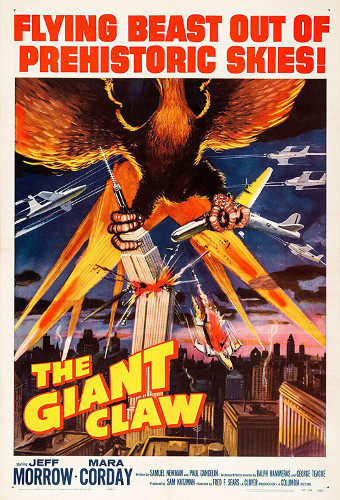
Civil aeronautical engineer Mitch MacAfee, while engaged in a radar test flight near the North Pole, spots an unidentified flying object. Three jet fighter aircraft are scrambled to pursue and identify it but one ages missing. Lt. Gen Edward Considine is angry at MacAfee over the loss of a pilot and jet over what they believe to be a hoax. Then an airplane that MacAfee and mathematician Sally Caldwell are flying in comes under attack by a UFO and they crash-land in the Adirondacks, where Pierre Broussard a French-Canadian farmer, comes to their rescue and reports seeing La Carcagne, a monster of local folklore. It seems that the beast has come from outer space. How can it be destroyed?
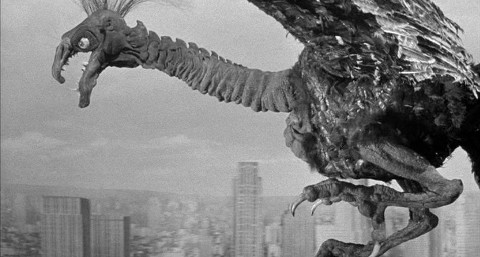
Originally double billed with The Night The World Exploded, The Giant Claw was the film in this set that I was most looking forward to seeing; it’s renowned for being infamously bad, a film which, when the cast members attending their first screening of, were shocked to find themselves inter-cut with awful special effects, in particular one of the ludicrous monsters in screen history. Star Jeff Morrow walked out way before the end. However, having been a die hard monster lover since for over four decades, and in particular of the Japanese kind, I often get a real kick out of seeing a bizarre creature on screen even if it looks absurd and isn’t convincing, and will give a creature feature a pass if the makers had imagination and honestly did the best with whatever little money they had at their disposal. Indeed the huge inter-galactic bird here may look daft, a sort of cross between Beaky Buzzard and The Great Gonzo, and with a really stupid look on its face; one of this film’s funniest moments is when our chief protagonists see on film a close-up of its visage for the first time and the heroine screams at the supposedly ghastly sight. It seems to change size throughout and is never “as big as a battleship” despite people frequently saying this. But there are things I admire about it such as its moving nose which seems powered by early animatronics, while we even have some sympathy for it when its egg is being shot at. I honestly don’t think that it’s the biggest problem in a movie which otherwise largely consists of a few people in rooms either trying to come up with ways to destroy the monster and more stock footage than I’ve ever seen in a monster movie outside of Gamera: Super Monster. Yet the result is still hilarious fun, especially when the performers play it very straight so that it often plays like a precursor to Airplane! The dialogue usually alternates between scientific gobbledygook, lousy jokes [I’ll never call my mother-in-law an old crow again”] that you can’t help but laugh at anyway, and just plain weirdness like a scene of romantic dialogue mostly spoken in baseball metaphors.
A very crude globe of the Earth that cuts to grainy footage of machines being built plays under more Kaztman narration about progress and science, narration that then continues as it points out our three main protagonists [“people doing a job” ], explains what radar is, and even carries on over our first scene ‘proper’ of a pilot sighting the monster, “a significant moment in history, a moment where our aeronautical engineer Mitch MacAfee electricity saw something in the sky, something that was almost the beginning of the end of life on this Earth”. It returns later on several times, either telling us what we can work out for ourselves anyway or seeming to have been inserted to paper over unshot footage [or footage deemed too poor even for this movie]. The bird is just shown as a dark blur at first, then is described by Pierre Broussard as – get this – “the face of the wolf and the body of the woman, with wings bigger than I can tell”. More incidents involving planes and then visual evidence leads to MacAfee, his co-worker Sally Caldwell and Dr. Karol Noymann seemingly being the only ones tasked with working out and then building [in record time of course] a weapon to destroy the creature, but then the screenplay by Samuel Newman and Paul Gangelin does seem to have been written by young children. It’s worked out that the creature, probably the first giant one from outer space in movies, is composed of antimatter, something that makes it invisible to radar and projects a forcefield that causes bullets and rockets to bounce off it – but this is contradicted by the many scenes of the bird biting into buildings, planes, trains and parachutists. The train bit is especially noteworthy; the bird plucks a freight train from its tracks and carries it off into the sky but the carriages stay joined together while the engine still puffs away! Much of the destruction we either just hear about or is represented by a second or two of stock footage, though the special effects crew did attempt a bit of city smashing at the climax with solid results considering the budget.
Much of the wrecking though, as well as fleeing crowds, are represented by shots from Katzman’s three Ray Harryhausen pictures; you can even briefly glimpse a crashing saucer in one shot taken from Earth Vs The Flying Saucers. Many older, poor-looking shots also turn up, and is that the same building blowing up twice? The actors seem disconnected from all this, stuck in small, sparse sets that usually don’t even have any window views, just the same white backdrop that we see in all the special effects shots except for one geographically impossible blow-up of a shot of the Capitol Building where you can spot people frozen in midwalk. Wires are visible everywhere; it’s possible that this may not have been the case before High Definition but I somehow doubt it considering how clear some of the grips are. Yet the performers, probably thinking of all this amazing spectacle that technicians were hopefully conjuring up at the same time, try their very best. Jeff Morrow is easily the most charismatic of the leading men in these four films, and has some chemistry with co-star Mara Cordey. Even though the scene where he kisses her while she’s asleep probably either wouldn’t be seen in a film today or would be followed by Sally emphatically telling Mitch off for sexual assault, the character of Sally is professionally on a level field with the men. Morris Ankrum from the previous Kaztman epic returns, here as Considine, one of the countless military commanders he seemed to play. Is The Giant Claw as bad as reputed? I guess it is in some respects, but I’m often reluctant to call a film bad if it’s lots of fun, as this one is. I laughed and laughed. The biggest problem really is that they tried to pull of something that was impossible to properly pull off with such a tiny budget. But ambition is always admirable.
Rating: 









SPECIAL FEATURES
Brand-new introduction by critic Kim Newman [12 mins]
I was kinda hoping that Newman would defend the bird but didn’t honestly think that he would; however he does, pointing out things he likes about it and which work well to him. He’s in the minority, but then I guess so am I really. He also says how Harryhausen may have been intended to originally do the effects but probably turned the job down, and tells a nice story about Cordey; she starred in Tarantula which also featured Clint Eastwood in a small part, something Eastwood may have remember as he gave her roles in some of his films much later.
Brand-new audio commentary by critics Emma Westwood and Cerise Howard
The variation in the talk tracks concludes with one but two people which, considering the film at hand, is appropriately light hearted and even jokey, though evnen I was pleased that it didn’t continue with its opening bird puns as promised. Westwood and Howard are in no doubt as to its low quality, but still clearly enjoy it. While we don’t get a huge amount of background information, there’s more scene specific chat than the last track, an observation that in some ways the film resonates more clearly now than it must have been in 1957, and much gentle ribbing. They also spend a long time trying to collect their feelings about the monster. This is the least scholarly of the commentaries, but a lively listen.
Family Endangered!, a brand-new visual essay examining the theme of Cold War paranoia in Sam Katzman monster movies, by critic Mike White [12 mins]
Much of what White talks about can be heard elsewhere in a set which does repeat itself a bit in terms of contextual material, but I suppose that’s to be expected. We do learn that Katzman averaged a whopping ten films a year, that James B. Gordon could be a pseudonym for Kurt Siodmak, and that the bird in The Giant Claw can be seen as a metaphor for fear of missiles. White also adds some of his own views on the films.
Condensed Super 8mm version of The Giant Claw, produced for home cinema viewing [6 mins]
This abridged version is poorly put together, even missing the beginning of a sentence, but you can’t say that it’s not appropriate for the film
Theatrical Trailer [2 mins]
Image Gallery
Overall these films look fine, with deep blacks and considerable though not artificial sharpness, Creature with the Atom Brain and Zombies Of Mora Tau easily being the best. The Werewolf has a bit of print damage and sometimes looks faded; maybe a first generation print wasn’t available. The Giant Claw probably looks the worst due to a lot of the stock footage being in poor shape; that just couldn’t be helped.
High Definition Blu-ray (1080p) presentations of all 4 films
Original uncompressed mono audio for all films
Optional English subtitles for the deaf and hard of hearing
Fully illustrated 60-page collector’s book featuring extensive new writing by Laura Drazin Boyes, Neil Mitchell, Barry Forshaw, Jon Towlson and Jackson Cooper
80-page collector’s art book featuring reproduction stills and artwork from each film and new writing by historian and critic Stephen R. Bissette
2 double-sided posters featuring newly commissioned artwork by Matt Griffin
Reversible sleeves featuring original and newly commissioned artwork for each film by Matt Griffin
I sometimes wonder if Arrow treat some films with more respect than they deserve, but I thoroughly enjoyed all of these, all four are quite rewarding. This set is must if you like old ‘B’ movies. Highly Recommended.





Be the first to comment